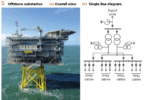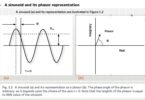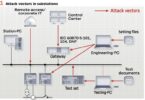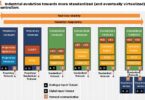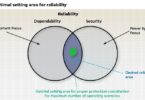Diego Gasca, Omicron Electronics, Austria
ACKNOWLEDGEMENTS
This work is carried out through the Constellation project which is funded by Ofgem’s Network Innovation competition. The project is led by UK Power Networks.
In the Constellation project, developed by UK Power Networks (UKPN) in the south of the UK, it is required to test an innovative wide-area protection system (WAP) aimed at improving the islanding detection in Distributed Energy Resources (DERs), as well as testing a decentralized Local Active Network Management (LANM) that acts as a backup to the central system and is aimed to maximize the DER output even during communication failures – a critical aspect in achieving Net Zero targets – while simultaneously limiting reverse power at restrictive points in the system caused by high-density DER penetration.
Constellation also addresses the use of new technologies such as virtualization and the use of 5G communication networks as convergence platforms, enabling a streamline deployment, as well as remote management and carbon footprint reduction.
Similarly, the testing solution employed will run on an industrial-PC prototype platform, avoiding the need for traditional testing equipment like voltage and current amplifiers and binary inputs and outputs, as the project is primarily based on IEC 61850 Process Bus technology.
The Constellation Project
Constellation is one of UK Power Networks’ flagship innovation projects, which will be delivered between May 2021 and September 2026 in partnership with several vendors and was awarded funding in 2020 by Ofgem as part of the Network Innovation Competition (NIC) funding mechanism.
The project aims to demonstrate, through a series of live site trials, how novel protection and control solutions located within DNO substations can:
- Facilitate the reliable connection of increased Distributed Energy Resources (DER) on to power distribution networks; and
- Protect the use of smart services to reduce the risk of system wide frequency (instability) events by de-risking the likelihood of sudden and widespread DER curtailment and/or disconnection
Constellation is a world first innovation initiative which is essential to facilitating Net Zero through enhancing the core of the distribution network – substations. In the future, DNOs will rely on services provided by DER assets to operate their networks optimally and reliably.
The Constellation solutions will enable a resilient and flexible approach to network protection and control, to enable DER to support the network.

Virtualized WAP for Effective Anti – Islanding
To prevent unintentional islanded operation of DERs, UK regulations G99, similar to many others worldwide, establish the requirements for the use of Loss of Mains (LoM) protection function as a pre-condition for connecting DER above 5 MW to the grid. Typically, the most widely used method for LoM is Rate of Change of Frequency (ROCOF) protection, which allows for more sensitive disconnection detection and prevents nuisance trips during voltage or frequency fluctuations. Although the ROCOF function prevails as the best alternative, there are still concerns about potential cascade disconnection of distributed generation caused by wide-area disturbances, which negatively impact system stabilization during these events.
The method proposed in Constellation to enhance ROCOF effectiveness involves detecting external system oscillations and transmitting a blocking signal via a 5G radio communications to the DER-sites ROCOF functions, ensuring that large-scale instability events do not trigger unwanted cascade disconnections. Complementarily, the project proposes the transmission of an intertrip signal from Grid sites to DERs, when the remote substation bus topology changes, indicating bus de-energization, or creating islanding operation conditions.
The above-mentioned functionalities, among others included in the project but not mentioned here, are carried out through the virtualization of the centralized protection solution CPC provided by a vendor and running as virtual machines on redundant servers located at the Grid 33 kV site and the equivalent server at each DER site.
Testing Setup for WAP: During FAT, the University of Strathclyde’s PNDC laboratory extensively validated system responses through a dedicated real-time hardware in the loop simulation platform. Later, site testing is required to verify the correct system response.
Given that the two aforementioned protection schemes involve communication between separated systems over a 5G network, the field-testing solution must consider:
- Portable or small form factor for permanent installation in the server cabinet
- Simultaneous injection at multiple geographically distant points (distributed and synchronized testing)
- Injection of multiple of IEC 61850 Sampled Values streams at Grid and DER sites
- GOOSE messaging subscription from virtualized platforms
- GOOSE messaging simulation from all Switch Gear Control Units (SCUs) related to the intertrip logic
- ROCOF simulation at different system nodes with impact in the injected measured points
- Simulation of breaker openings events across multiple bays, corresponding to different IEDs and GOOSE messages
- Capture of time aligned responses (blocking and tripping) at multiple sites for evaluation of the communication network
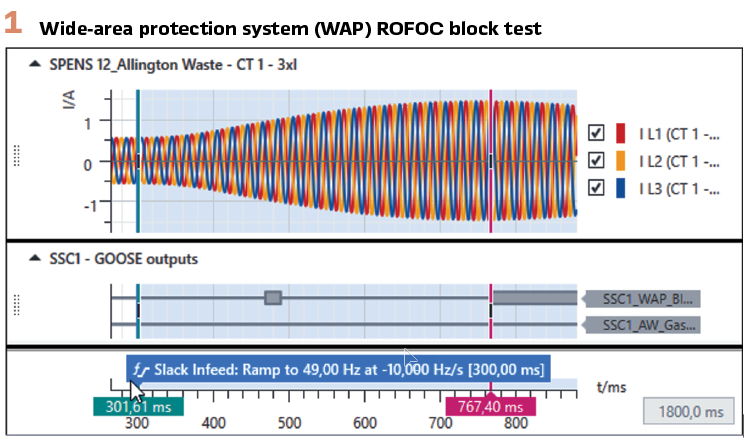
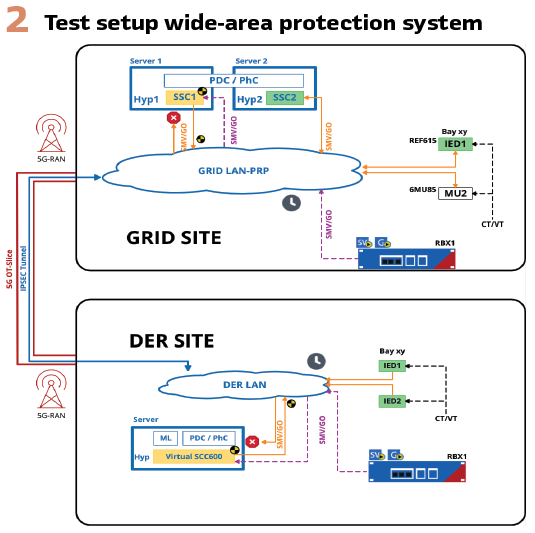
Based on these requirements, the proposed test solution uses transient network simulation software in combination with a prototype 19” Industrial PC-based hardware for system-model-based testing. Figure 2 shows a simplified test setup for one Grid and one DER site (the full project includes two Grid sites and up to 4 DERs connected to the same Grid).
The test is successfully evaluated by capturing the ROFOC blocking signal sent from the Grid 33 kV side and correctly received by the protection at the DER site, thus preventing an undesired trip in time. Additionally, to assess the 5G channel response time, it is possible to capture the blocking signal within the LAN at both locations and calculate the total message transmission time. For the Constellation project, the target is 3 ms, to be achieved through the use of a 5G OT-slice customized for real time applications and managed by a vendor as project partner. (Figure 1).
The intertrip function testing, for opening the breaker at the DER site due to busbar disconnection detection on the Grid 33 kV side, is achieved by simulating all IEDs feeding the busbar and involved in the intertrip logic within the centralized protection and control (CPC). Thus, by simulating circuit breaker opening events, the necessary conditions for triggering the intertrip logic are provided. Similarly, the test is correctly evaluated by capturing the intertrip signal sent by the Grid 33 kV side and correctly received by the protection at the DER site, instantly opening the breaker, as well as evaluating the speed of the 5G network.
Figure 3 shows the power system modelling interface within transient network simulator (TNS), where a virtual IED has been included in each bay, as well as two centralized and virtualized CPC units. In the Constellation project, the IEDs at each bay act as Merging Units (MU) and SCU devices feeding both CPC units (two MU/SCUs are provided for most bays to achieve a more robust redundant scheme, but is not included in this document), while also serving as the primary protection and control units for each bay – project phase 1. Later, after sufficient confidence is achieved in the WAP, system centralized and virtualized protection, the bay-IEDs will switch to MU/SCU-only mode, transferring protection and control functions exclusively to the CPC units – project phase 2.
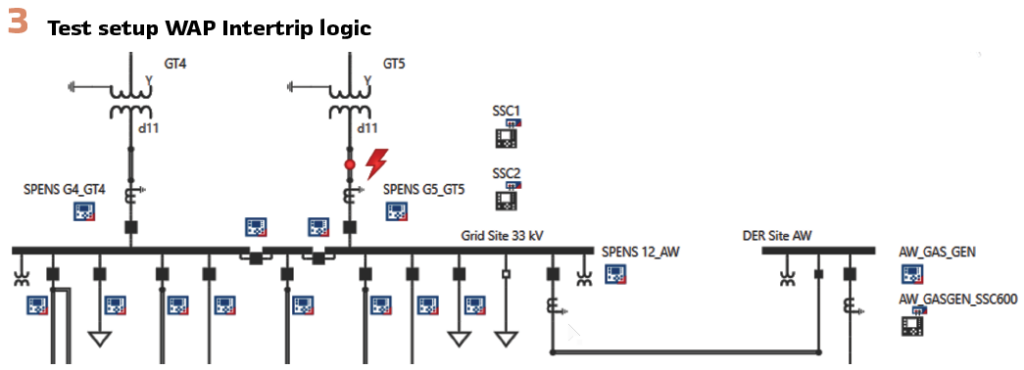
LANM for DER Output Optimization
The Net Zero goal has significantly accelerated DER deployment across the UK, especially in high-demand areas, leading to increased risk of elevated reverse power flow at certain critical Constraint Points, potentially causing backup protection maloperations at power transformers.
The generation control dynamics are usually carried out through the system: Active Network Management (ANM), which collects information from the entire power system and communicates directly with each DER to regulate the maximum allowable power output. This system, which we will call here: Central-ANM (CANM), began to be implemented in 2009 and has proven its effectiveness, currently controlling over 500 MW of distributed energy resources in UKPN, such as solar and wind energy, in the southeast of England.
Constellation seeks to increase resilience through the implementation of a Local Active Network Management (LANM) system at the substation and DER levels, ensuring generation optimization even in the event of communication failures.
For assertive decision-making, LANM must receive power measurements and topology statuses from the substations and DERs connected and based on them it calculates the reverse power margin (called Headroom in the following) that safeguards:
- Maximum possible generation of all DERs, based on the commercial agreements of each operator
- The maximum power at critical points in the system (132/33 kV power transformers) does not exceed the backup overcurrent protection settings towards the 132 kV lines.

In the event of CANM-DER communication loss, LANM system will take control and maintain optimal power flow until communications are restored or timeout.
LANM system aims to go even further by implementing control decisions based on Machine Learning, in the event of communication failures that leave DERs completely disconnected from the rest of the system, allowing them to continue generating temporarily under the observation of local measurements.
Test Setup for LANM
So far, it has been identified that the LANM system is responsible for DER output control based on distributed measurements and, although it limits power flow to not exceed protection settings, LANM itself is not part of the protection system but of the control system. Conventionally, test solutions with dynamic current and voltage injections have been linked to the verification of protection functions or the validation of control system measurements. However, for LANM testing, the field test method brings new challenges by including the following requirements:
- Portable or small form factor test solution
- Distributed and synchronized injection tool
- Injection of multiple of IEC 61850 Sampled Values streams to feed PMUs
- Dynamic power flow adjustment using distributed measurements
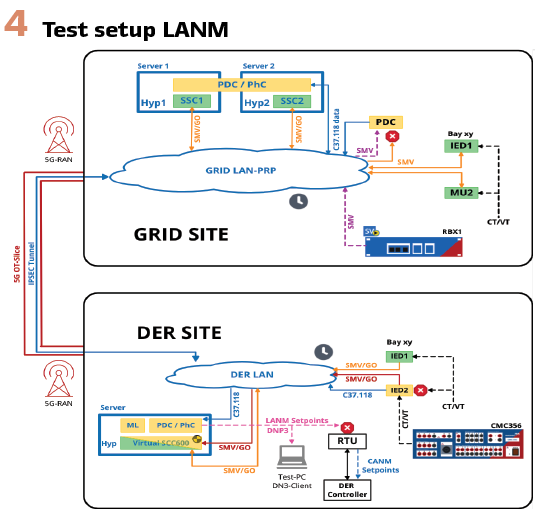
For this testing method, using TNS has also been proposed as preferred testing tool based on its power system modeling capabilities and also as a common solution beside WAP. Figure 4 shows a simplified test setup for Grid and a DER site.
One of the Constellation project partners, and the LANM supplier, has also virtualized its PhasorController solution to run it as an additional virtual machine executing in parallel to the previously mentioned WAP solution, sharing the redundant server platform.
When testing LANM, dynamic headroom conditions are simulated through synchronized injections at the Grid and DER sites, adjusting topology events to trigger:
- Negative Headroom – Headroom violation: A critical situation that is either not permitted or only transitory, caused by changes in power flow-such as a significant decrease in local consumption or a substantial increase in unmanaged generation (e.g., non-flexible connections). In these circumstances, LANM must curtail DER output following the priorities defined in the commercial agreements of each operator.
- Positive Headroom and DERs with available capacity: When a significant portion of the power is consumed locally in the same DER location and/or at the 33 kV substation, and it is possible to release more power from the DERs.
Figure 5 shows the system power flow simulated in TNS for one of the substations and DERs of the scope. The test is achieved with simultaneous injections of synchronized measurements on the secondary side of both power transformers at the substation site and at the DER site. The LANM system calculates the headroom as the sum of both powers minus the maximum permissible power flow setting at the constraint point. The circuit breaker positions of each transformer GT4/GT5, as well as the bus couplers, are estimated based on the voltage measurements between both buses.
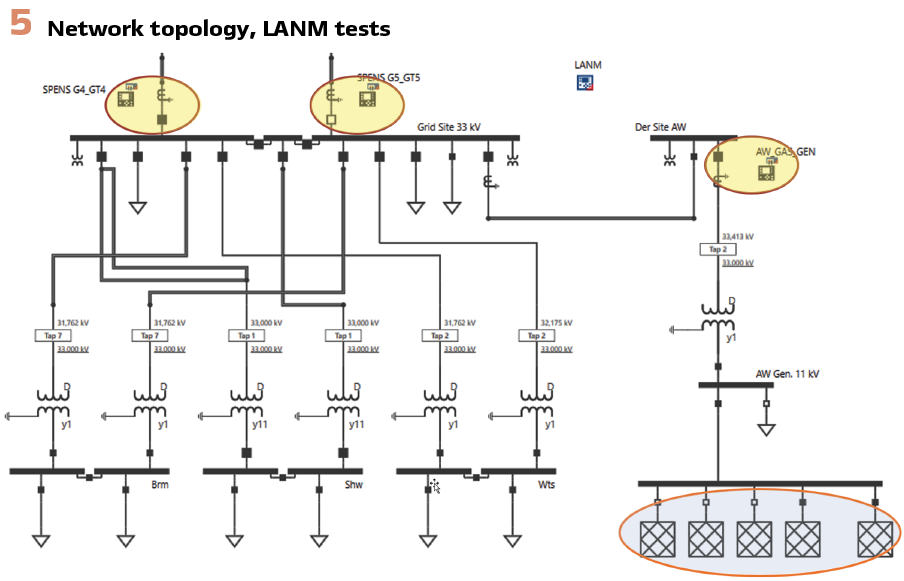
In TNS, power flow variations are achieved by adding circuit breaker events.
As shown in Figure 6, in (1), the headroom is positive, indicating an acceptable amount of power imported from the grid. Subsequently, a power flow change event is created by disconnecting a significant load, increasing negative power flow below the permissible headroom value (2). After the headroom violation, the LANM system starts issuing curtailment orders to the DER until reaching a positive headroom value (3); to simulate the system’s response to these commands, circuit breaker events are added that disconnect generation steps from the DER. As can be noted, the total capacity of the DER has been divided into small components for the purpose of simulating the control steps that LANM sends. However, in practice, the DER is a single generation unit, in some cases solar, wind, or gas.
To test the LANM system’s response to positive changes in headroom, the reconnection of loads in the local network is simulated, reducing significantly the power imported by the grid (4) to even positive export values. The LANM control system detects a positive headroom, in addition to perceive the available capacity in the DERs, and consequently releases more power from them, following the priority order established by the commercial contracts of each DER operator (5).
Other test scenarios have also been considered that address the occurrence of system faults, leading to disconnection or fail-safe generation status, but they are not covered here.
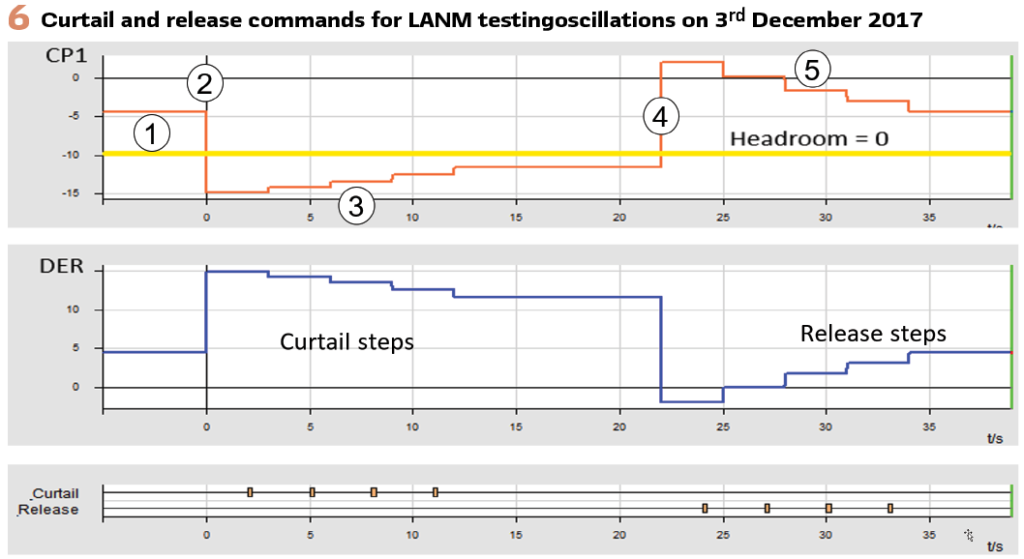
Testing of Virtualized IEC 61850 Systems
Virtualized systems are essentially communication-based systems. As they run on industrial servers instead of conventional IEDs with analog current and voltage inputs the use of the IEC 61850 standard and Sampled Values, GOOSE, and Client/Server services are the default solution. In general, all digital substation testing concepts are applicable in virtualized environments; however, some special considerations must be analyzed when developing a test strategy.
Paradigm Shift with LPHD/Sim: By definition, it is oriented to set the physical device (as a complete component) in Simulation mode, enabling the reception of Sampled Values and/or GOOSE messages from test equipment. In centralized protection solutions (virtualized or not), it must be considered that there is no Simulation control for each bay; instead, the LPHD/Sim control will affect the entire centralized protection, and thus all its bays or functions will be affected.
This has special implications for group functions such as bus differential protection (87B) or breaker failure (50BF), for what isolation from the rest of the functions housed in the same centralized protection would be desirable.
However, considering the convenience of virtualized solutions, it is very likely, and even recommended, to have two redundant servers, allowing one server to be tested while the backup remains in operation.
Predictability with Shared Hardware Resources: Traditional protection systems are based on hardware platforms with predictable responses; the hardware architecture and resource distribution have been designed and tested by the manufacturer to ensure a deterministic response. In virtualized solutions, the software platform provider has rigorously tested its solution on a testbed under a controlled environment, considering the allocation of CPU cores, cache memory, and Ethernet ports (among others), isolated and dedicated to specific tasks; use of hypervisors with well-defined processes customization, and other parameters that ensure the industrial-Server executes protection processes as deterministically as possible.
However, in situations where the customer wants to maximize the benefit of the hardware platform and run multiple solutions in parallel, from different providers and by using different virtual machines, sharing hardware resources (although isolated by software), the required verifications increase and cannot be directly compared to the results obtained by each manufacturer in isolation.
It is recommended that testing, and especially system monitoring, be conducted over long periods during FATs when all virtualized solutions are in full operation, corroborating that hardware usage has been correctly tuned to provide the requirements that each type of application needs to consume.
Biographies:

Diego Gasca studied Electronics and Telecommunication Engineering. He received an MSc. in Engineering Project Management and has more than 15 years of work experience in that field. Diego started at OMICRON in 2016 as Regional Application Specialist for protection and automation in Latin America. At the moment he works as Application Services Expert at OMICRON Austria supporting customers in innovation projects with focus on digitalization, He also serves as chair of the vPAC Alliance WG on Lifecycle and Testing.

Colin Scoble is an Experienced Protection Engineer with a demonstrated history of working in the utilities industry. He is skilled in Energy, Power Systems, Renewable Energy, Power Plants, and Project Engineering. He is a strong operation professional with a master’s degree focused in Power Distribution Engineering from Newcastle University.

Gustavo Leonardo is a Protection and Control Engineer at UK Power Networks and holds a degree in Electrical Engineering from the University of São Paulo (USP). He has over eight years of experience in designing and commissioning protection schemes with various intelligent electronic devices (IEDs), as well as in deploying digital substations based on the IEC 61850 standard.



